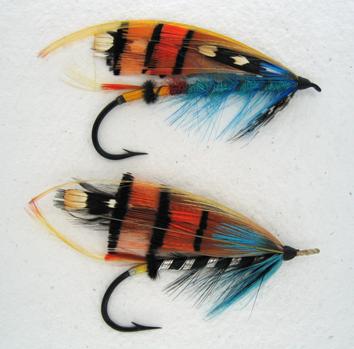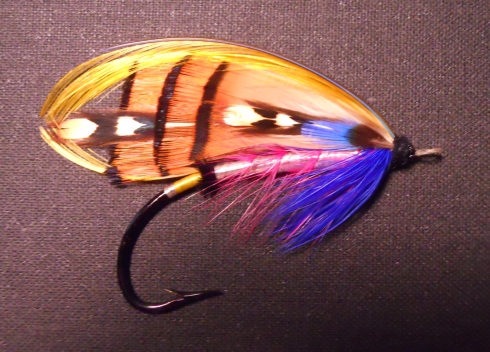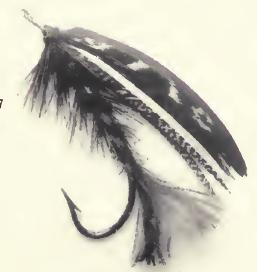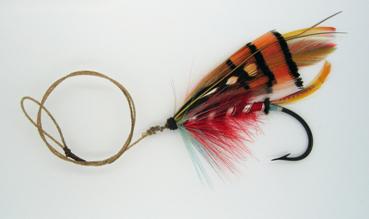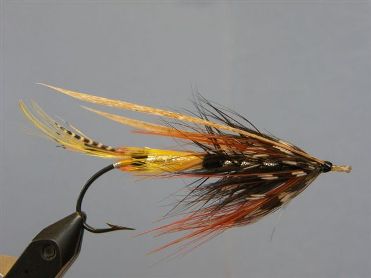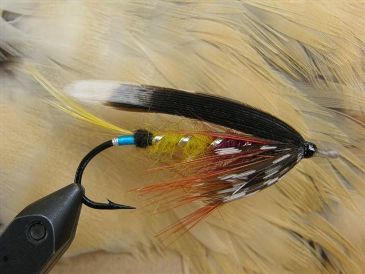 |
 |
|
On this page you will find photos of vintage flies that didn't go into the Aberdeenshire page - they may well have been used in the area, but are not documented as Dee, Don, Deveron, Ythan etc. Named above the photo, if I know the name! I have also decided to add some dressings from the Fishing Gazette (mostly Scottish) Hardy's Ballina Salmon Flies from the 1894 Catalogue
Pattern from The Salmon Fisher (1890) by Charles Hallock (who mentions that he got the pattern from the Fishing Gazette)
Black and Claret Pattern from Frank Hearn – Fishing Gazette 25th August 1900 Tag: Silver twist and orange silk Tail: Chatterer and gold topping Butt: Black herl Body: Black silk Rib: Four or five turns of silver twist Hackle: Very dark claret down the body Throat: Blue jay or teal Wings: Mallard, blue macaw, topping over all Head: Black herl
Black Dog
P.D. Malloch, Fishing Gazette, 1886 Tag: Silver twist and yellow floss silk Tail: A crest and a few fibres of scarlet ibis Butt: Black ostrich Body: Black floss silk, ribbed with gold and silver oval tinsel, orange floss run in between the two tinsels; black heron hackle at shoulder Wing: Bronze peacock herl, silver-grey turkey, bustard, pintail, teal, wood duck, mallard, swan feathers dyed red, yellow, and blue, jungle cock at each side, blue macaw crest over wing. Head: Black wool If the fly is to be dressed larger than above, a black cock’s hackle is run down over the body. The Black Dog is one of our very best
Black Goshawk Pattern from Frank Hearn – Fishing Gazette 25th August 1900 Tag: Silver twist, lemon silk Tail: A topping and Indian crow Butt: Black herl Body: Black silk Rib: Four or five turns of broad silver tinsel Hackle: Dark claret down the body Throat: Teal or Jay Wings: Half dozen good coloured toppings Horns: Blue macaw Cheeks: Chatterer Head: Black herl
Black Jointer Pattern from Frank Hearn – Fishing Gazette 25th August 1900 Tag: Silver twist, orange silk Tail: Topping Butt: Black herl Body: Four or five joints of black silk, and at every joint three or four rolls of fine silver twist, main first joint near tail, one streak of blue mohair then standing on the back and tied at every joint of silk claret mohair. Throat: Claret hackle and Jay Wings: Tippet, golden pheasant tail, bustard, mallard and teal, topping over all. Horns: Blue macaw Head: Black
Black and Pattern from Frank Hearn – Fishing Gazette 25th August 1900 Tag: Silver twist Tail: Topping Body: Black and orange silk joints down the whole body to the throat, with three or four rolls of fine silver twist at the end of each joint, main, blue, yellow and claret mohair standing all down the back. Throat: Golden olive hackle, and blue Jay or teal Wings: Tippet, gold pheasant tail, bustard, mallard and teal, topping over all. Horns: Blue macaw Head: Black ostrich herl
Black Price - You don't often see a vintage one of these! Blue and Black Rangers
The Bulldog The Canon
The greatest slaughterer of any of the dull-day, low water flies used on the Helsdale, and for summer fishing a favourite on several other North-country rivers, is described thus:- Tag: Gold twist. Tail: A topping. Body: Wholly mohair - three turns medium claret, four turns yellow, three turns bright green, two turns dark claret. Ribbed: Gold tinsel and gold twist. Hackle: Claret magenta, from first turn yellow mohair. Wings: Two tippets back to back, and enveloping these, four strips richly-marked dark mallard - two on each side; no topping. Horns: Blue and yellow macaw. Head: Black wool. The Canon is also bodied with seal’s fur.
The Chatterer - this one is not vintage - but tied by Guy Heard
Duke of Edinburgh
Evans's Salmon Fly From the Fishing Gazette
Hook No. 6 or 7. Mulberry silk floss body, golden pheasant’s crest tail, under which are several turns of the thinnest silver wire and some turns of the floss silk; the silver wire is then carried over the body spirally, close under the wings is wound a small dark partridge hackle. The wings are of - First, brown speckled mallard; second, about a dozen fibres of the golden pheasant’s ruff; third, three or four fibres of bright green paroquet, and above them are about a dozen strands of dark mottled, or rather, striped, turkey. Above the wing is hackled either a striped blue jay’s feather, or a marlow-buzz hen’s hackle, which is, perhaps, preferable; and then a beading of ostrich herl completes the fly.
Fenian Pattern from Frank Hearn – Fishing Gazette 25th August 1900 Tag: Silver twist, orange silk Tail: Indian crow and topping Butt: Black herl Body: Green olive silk Rib: Silver tinsel Hackle: Golden olive down the body Throat: Jay Wings: Mallard, topping over all Horns: Blue macaw Cheeks: Chatterer Head: Black herl
Golden Olive Pattern from Frank Hearn – Fishing Gazette 25th August 1900 Tag: Silver twist, orange silk Tail: Gold topping and Indian crow Butt: Black herl Body: One third light blue mohair, remainder golden olive seals fur. Rib: Silver twist or tinsel Hackle: Golden olive down the whole way Throat: Jay Wings: Tippets, bustard, pheasant tail, mallard and teal, topping over all Horns: Blue macaw Cheeks: Chatterer Head: Black herl
The Green Islander
Tied by Australian Bob Frandsen
Tag: Silver twist and gold color floss. Tail: A topping, red parrot, and widgeon. Butt: Black ostrich Body: Two turns gold colour floss, remainder light pea green fur, very much picked out. Ribbed: Flat silver tinsel (broad) and silver twist. Hackle: Light pea green, commencing at gold colour floss and closely wound on. Shoulder: Light yellow hackle – medium quantity. Wing: First, two broad strips of brown turkey feather, with long black band and longish white stip, then two strips bustard, married strips blue and green swan, and lastly (on top), strips of pheasant tail feather. Cheeks: Jungle, single. Horns: Blue Macaw. Head: Black wool. Dressed by John A. Dunbar, fishing-tackle maker, The Esplanade, Oban, N.B.
The Helmsdale
Tag: Silver twist and dark orange floss. Tail: A topping and Indian Crow. Butt: Black herl. Body: Three turns yellow floss, the rest golden yellow seal’s fur, well picked out. Ribbed: Silver tinsel. Hackle: Golden yellow - from floss to head. Shoulder: Greenish-blue hackle. Wing: Four strips cream-coloured feather turkey tail, two on each side, the inner ones back to back. Sides: Indian crow feathers (long), two on each side. Horns: Blue and red macaw. Head: Black wool.
For comparison the above photo shows some vintage Helmsdales dressed to the much simpler Kelson/Hardy/Hale pattern. Helmsdale (Gaudy) Eagle
Tied by Bob Fransden (with the genuine hackle)
Tag: Silver twist and light-blue floss. Tail: A topping; fibres of tippet, of green parrot and of red rump feather golden pheasant. Butt: Black herl. Body: Three turns yellow mohair, same of orange (medium shade); the rest red and blue in equal proportion. Ribbed: Silver tinsel. Hackle: Golden yellow eagle down - from beginning of red. Shoulder: Guinea fowl hackle. Wing: Two long jungle fowl, the full length of the wing; enveloping these, two tippets - one on either side - extending to the tag; golden yellow mohair and bronze peacock herl above; and two toppings over all. Sides: jungle fowl, three spots. Cheeks: Chatterer. Head: Black wool.
Local Helmsdale Patterns No. 1. - Norman Fraser Tag: Gold twist with yellow floss. Tail: A topping and jungle - two small spots. Butt: Scarlet wool or scarlet herl. Body: Narrow oval tinsel. Ribbed: Medium oval gold tinsel. Hackle: Pale green, and at shoulder only. Wings: Double strips of cream colour feather turkey tail - that is, four strips in all, two on each side, the inside ones back to back; a topping or two over. Cheeks: Jungle, two spots each side. Head: Black wool. No. 2. Tag: Silver twist and yellow floss. Tail: A topping. Butt: Black herl. Body: Two turns yellow floss, the remainder yellow mohair. Ribbed: Oval silver tinsel. Hackle: Yellow, shade of body, from floss to head; pale green hackle at shoulder, but only a turn or two. Wings: Double strips of the lightest shade cream colour feather turkey tail, place as in the case of No. 1; two toppings over. Head: Black wool. No. 3. Tag: Silver twist and medium orange floss. Tail: A topping Butt: Black herl Body: Two turns dark orange floss, the remainder golden olive mohair. Ribbed: Oval gold twist. Hackle: Golden olive, from floss to head; guinea fowl at shoulder. Wings: Small tippet, and above that one large strip (full size of wing) brown feather turkey tail on each side; red and green swan; and a long strip of dark mallard, half the breadth of the wing, outside all - both sides; no topping. Head: Black wool.
The Highlander. “Standard” on the Thurso
Tied by Bob Frandsen Tag: Silver twist gold colour floss. Tail: A topping and a few sprigs of tippet. Body: Two turns light orange, three turns red the remained grass green seal’s fur. Ribbed: Hackle: A natural black from the light orange joint and very full at the shoulder. Wing: Strands of tippet, orange, green, blue, red, and yellow dyed swan; mallard and widgeon, the later rather prominent; topping over all. Cheeks: Jungle Head: Black wool
Hold Fast
Tied by Bob Fransden Pattern from Frank Hearn – Fishing Gazette 25th August 1900 Tag: Silver twist and orange silk Tail: Topping and chatterer Butt: Black herl Body: Black silk Rib: Silver tinsel “ Throat: Golden olive hackle and jay Wing: Tippet, bustard, pheasant tail, mallard, topping over all. Horns: Blue macaw Head: Black herl
Indian Crow Grub
Judge Tag: Gold thread and orange floss Tail: A topping and blue kingfisher Body: Flat silver tinsel ribbed with Rib: Treble gold twist Hackle: Over body, a rich golden olive, bright and sparkling Throat: A very bright brown, over which is a jay Wings: Strips of rich brown bustard and swan, deep yellow, with strands of golden pheasant neck, blue macaw rump and green and red parrot, with two toppings over. Cheek: Chatterers Horns: Blue macaw Head: Peacock herl Invented by Mr Wm. Doherty of Bushmills County Antrim, which of whose patterns hold first place in the estimation of the best anglers on the Bush and Bann.
Kate
The MacNicol
Tied by Australian Bob Frandsen (that's him in the background)
A river keeper on the river Forss, a fish culturist, and a first rate fisher and fly-tyer, MacNicol inveneted that great slaughterer, the “MacNicol,” which, as an all-round fly, is one of the best known to be use in the
Tag: Silver twist and yellow floss Tail: A topping; sprigs of tippet; teal, scarlet ibis and green parrot. Butt: Black Ostrich. Body: In two sections – the first section a trifle shorter than the second. First section, rose-pink floss, ribbed with silver twist, and butted with black ostrich. Light majenta hackle at the butt of this section, with a tuft of dark majenta mohair (tied in above but only on the back of the iron at said butt), extending there from to very near the tip of the tail. Second section, pale blue floss, ribbed with silver twist (oval), and gold colour hackle over the entire length of section. Shoulder hackle, yellow macaw; guinea fowl hackle at throat. Wing: Golden pheasant tippet feather, ditto tail feather (a few narrow strips); married strips, orange yellow, crimson, and dark blue swan; teal and pintail; broadish strip of summer duck on either side, a longish wisp of gold colour mohair on top of wing, and a topping all over. Sides: Jungle – two spots. Cheeks: Chatterer Horns: Blue macaw Head: Black ostrich. Dressed on any size of iron required, this gorgeous and very effective salmon fly (MacNicol) may be had on applying to John Alexander Dunbar, gun and fishing tackle maker, The Esplanade, Oban, Argyll, N.B.
The Major The Major is a good general fly, and a great favourite on the Naver. Dressed on a 4/0 Tag: Silver twist and crimson floss Tail: A topping Body: Composite – viz., four turns light blue, ditto gold colour, five turns of bright claret, and ditto of dark blue fur – all the body fur; and the two last named colours well picked out. Ribbed: Silver tinsel and silver twist. Hackle: Bright claret, commencing from the gold colour fur. Shoulder: Bustard (sparingly) and guinea fowl.. Wing: Two tippets back to back; outside, and on either side of these, a snipe (under the wing) feather; and a golden pheasant spear feather outside the snipe feather; bustard and pheasant’s tail on top of the wing, and two toppings over all, with a yellow hackle (at head) over the wing. Horns: Blue macaw. Head : Blue wool Dressed by John A. Dunbar, The Esplanade, Oban, N.B. Mr. Francis Francis’s description of the Major:- Tag: Silver twist and ruby floss. Tail: Fibres of bustard hackle, tippet, and a topping. Body: Composite – viz., two turns of medium blue, ditto of dark orange, about four or five of bright claret, and two more of blue pig’s wool. Ribbing: Silver tinsel and gold twist, side by side. Hackle: A red claret hackle commencing from the orange wool; the blue wool picked out in longish fibres at the shoulder, over this a bustard hackle, then the wing, then over that a yellow hackle. The wing is composed of white ribbed snipe’s feather, with longish tippet on either side; over this, bustard and golden pheasant tail in strips, with red, blue, and greenish-yellow fibres, and over all topping; black head. This is a capital fly, but I think some of the dressing is rather overdone, and might be dispensed with. Size, No. 4 to 8. – Francis Francis: “A book on Angling,” 1867.
The March Murderer
Tag: Silver twist and yellow floss Tail: A topping and sprigs of tippet Butt: Black ostrich Body: Silver tinsel Ribbed: Plain oval tinsel Hackle: Claret majenta from first turn of oval tinsel; dark blue hackle at shoulder, not very full. Wings: Two tippets to half way up tail; two jungle to top of tail; over that two tippets extending to butt, with jungle outside reaching up to the lower bar; topping over all. Cheeks: Chatterer Horns: Blue Macaw Head: Black wool Dressed on On the 19th of March, the day after he invented it, Mr Dunbar, in half an hour, managed to kill two salmon - 27½ and 20lb. – with the original pattern and accordingly he christened it the March Murderer. Ever since that time it has proved itself worth of its name.
The Mohair Canary
Tag: Silver twist with yellow floss. Tail: Topping with sprigs of tippet . Butt: Black ostrich Body: Three turns yellow floss; remainder gold colour seals fur. Ribbed: Silver tinsel (oval). Hackle: Gold colour, black with centre, from floss joint; tuft of gold-clour mohair at shoulder. Wing: Gold coloured mohair and bronze herl (two-thirds of the former to one third of the latter) arranged thus: first a quantity of the mohair, then th eherl, and, lastly, the bulk of the mohair above. Head: varnised The “Mohair Canary” is great favourite with Thurso anglers. It is a “killer” on the Avon and Welsh rivers, and a popular fly on many of the best fisheries in
Morgan
The Modified Mohair Fly
Tag: Silver twist and yellow floss Butt: Black ostrich Body: Three turns yellow floss, two turns gold-coloured fur, three ditto scarlet fur, the remainder indigo blue fur. Bodied with seal’s fur by preference, but mohair may be substituted. Hackle: Yellow from silk joint. Ribbed: Flat twist (silver). Throat: Mixed hackle of yellow, green, blue, brown, buff, and red mohair. Wing: Peacock herl, and mohair of the same mixture as at throat – the mohair to preponderate slightly. Head: Varnished. Pattern supplied by the inventor, Mr John Alexander Dunbar, Oban, Argyllshire, to who we are indebted for much valuable information concerning the Thurso
A fly for Norway A On the whole, we have invariably found that the Black Doctor or the Black Dose, or a fly of similar darkness, is unsurpassed in that twilight between sunset and dawn which we call night in Tag: Silver twist, and yellow silk. Tail: A topping, Teal and Chatterer. Body: Two-thirds black silk; followed by one-third scarlet seal's fur. Oval silver tinsel ribs. Hackle: A natural black hackle up the body; gallina at throat. Wings: Two tippets, back to back, veiled with Teal, Gold Pheasant tail, Peacock herl and Mallard. A topping over all. Horns: Blue Macaw. Cheeks. Light blue Chatterer. I omit Jungle Cock in the wings, because I think that in this clear water, unless it be on a very dark night, or in a very big river, it is of doubtful advantage. I attach much importance to the Chatterer cheeks. Except the topping, nothing has such a lifelike gleam in the water. With regard to tippets for wings, I have some black and white, instead of the ordinary red and white, from (I think) a cross between Reeve's Pheasant and the Silver Pheasant, which I owe to the kindness of a friend. These I find very useful.
Orange Grouse Pattern from Frank Hearn – Fishing Gazette 25th August 1900 Tag: Silver twist, violet silk Tail: A topping and Indian crow Butt: Black herl Body: Rib: Silver tinsel or twist Hackle: Grouse hackle two thirds down the body Throat: Jay Wings: Tippet, pheasant tail, bustard, mallard and teal, topping over all. Horns: Blue macaw Cheeks: Chatterer Head: Black herl
Onset - so like a Dunt !
The Rainbow
A "Standard" for the Thurso. Dressed by Mrs. Tim Courtney, from Killarney. Which is made up, thus:- Tag: Silver twist and light-blue floss. Tail: A topping Butt: Scarlet ostrich Body: Three rolls yellow seal’s fur, and three ditto of each or the following colours of mohair in the order given – viz., scarlet, grass green, gold colour, indigo blue, and claret. Hackle: Yellow, from first joint. Ribbed: Oval twist (silver) Throat: Guinea fowl Wing: Fibres of tippet, two strips grey turkey: yellow, red and blue swan; bustard;l pheasant’s tail; two strips of brown mallard; ditto of Widgeon; and a topping overall. Cheeks: Jungle Heads: Varnished Pattern supplied by the inventor, Mr John Alexander Dunbar, Oban, Argyllshire, to who we are indebted for much valuable information concerning the Thurso
The Sandeman Flies
The following patterns come from the book "By Hook or Crook" by Fraser Sandeman published in 1894. Sandeman's flies were sold by Hardy Bros. from as early as 1897 as can be seen in the Hardy Catalogue Scan here. The following year Sandeman published "Angling Travels in Norway" which contains 4 colour plates of Norwegian Salmon Flies and a black and white plate that shows some of Sandeman patterns from "By Hook or Crook" - I have put some on here - but appolgise for the quality of the scan of the black & white ones - they do however give a better idea of the style than the, although beautiful, colour illustrations - they do remind me a bit of the Drum Style.
No. 1
Tag: Gold wire or thread, purple silk. Tail: Golden Pheasant topping. Butt: Black Ostrich herl. Body: Jointed in three divisions of Equal length of yellow, orange, and red floss silk (in order from tail). Gold tinsel from butt to head. Hackle. In three joints, yellow orange and red. Shoulder hackle: Black hackle red at points. Wings: Mottled brown turkey, grey turkey, golden pheasant tail, dark mallard, 4 narrow strips of blue dyed swan, 4 fibres peacock herl. Cheeks: Two bold slips of barred feather of summer duck extending well up the fly. This pattern has been most successful in all states of water, so much so that amongst friends it has gained the name of “the Undefeated.”
No. 2
Tag: Gold tinsel thread and yellow silk. Tail: Golden Pheasant topping. Butt: Black ostrich herl. Body: ⅓rd orange floss silk, ⅔rds dark blue silk and gold tinsel. Hackle: Blue cock’s (dyed). Wings (Mixed): Of light mallard, brown mottled turkey, golden pheasant tail, gallina, yellow dyed swan. Topping: Golden Pheasant. This is a very good pattern
No. 3
Tag : Silver tinsel. Tail: Yellow floss silk. Body: Pale blue silk; silver tinsel. Body hackle: Pale blue. Shoulder hackle: Reddy brown. Wings (mixed): Light mallard, golden pheasant tail, a few fibres of yellow dyed swan, a couple of sprigs of golden pheasant rump. This is especially good for thin water.
No. 4
Tag: Gold tinsel thread, yellow floss silk. Tail: Sprig of golden pheasant rump. Butt: Black ostrich herl. Body: Yellow floss silk, black hackle, gold tinsel. Shoulder hackle: Black. Wings: Golden pheasant tail, broad slip of barred summer duck. Topping: Golden pheasant. Cheeks: Kingfisher. Head: Black ostrich herl.
No. 5
Tag: Gold tinsel thread, yellow silk floss. Tail: Golden pheasant topping. Butt: Black ostrich herl. Body: Dark blue floss silk, brown hackle light in colour towards the points, silver tinsel and silver thread together. Shoulder hackle: Same as body. Wings (mixed): Grey turkey, bustard (Indian), golden pheasant tail and rump, unbarred summer duck, and red dyed swan. Horns: Blue and red macaw. Topping: Golden pheasant. Head: Black worsted.
No. 6
Tag: Gold tinsel thread. Tail: Golden pheasant tippet, and one small slip each of red and blue dyed floss. Butt: Black ostrich herl. Body: Four turns of yellow floss silk, the remainder in three equal divisions of pale blue, scarlet and black pig’s wool. Gold or silver thread. Hackle: Fiery brown. Shoulder-hackle: Dark grey. Flat oval gold tinsel braid. Wings (mixed): Golden pheasant tippet, mallard, golden pheasant tail, 2 slips dun turkey or, better still, of glead hawk, gallina, 2 slips grey turkey, 2 slips each yellow and blue dyed swan. Head: Black wool.
No. 7
Tail: Gold tinsel. Tail: Full whisp of orange pig’s wool. Body: Lower half orange pigs wool, upper half brown pig’s wool. Gold tinsel. Hackle and shoulder hackle: Brown. Wings, under: Dark green mallard. Wings, upper: Brown or dun turkey, whitish at tips.
No. 8
Tag: Gold tinsel thread. Tail: Unbarred summer duck, golden pheasant tippet and topping. Body: Lower half, Body hackle: From middle to shoulder dark red. Broad gold tinsel. Shoulder hackle: Fiery Brown. Wings (mixed): Dark brown turkey, mottled on lower half.
No. 9
Tag: Gold tinsel thread. Tail: Golden pheasant topping. Body: Lowest third, orange pig’s wool. Upper two thirds, brown pig’s wool. Gold tinsel. Hackle: Light red. Shoulder hackle: Light red. Wings: Gled hawk.
No. 10
Tag: Silver tinsel thread. Tail: Golden pheasant tippet. Body: 2 turns yellow pig’s wool, 2 turns red pig’s wool, remainder, green pig’s wool. Hackle: Green. Tinsel: Broad silver. Shoulder hackle: Light brown Wings, under: Teal Wings, upper: Boldly-mottled grey turkey, 2 small slips red dyed swan.
No. 11
Tag: Gold tinsel. Tail: Yellow floss silk. Body: Three turns orange pig’s wool, remainder black pig’s wool. Gold tinsel. Hackle and shoulder hackle: Light reddy brown. Wings (mixed): Golden pheasant tail, bustard, grey turkey, white and red swan, 2 wide slips gled hawk.
No. 12
Tag: Gold tinsel thread, and red floss silk. Tail: Golden pheasant topping and one kingfisher feather. Butt: Black ostrich. Body: ⅔rds up from tail, medium-sized silver tinsel braid, then a butt of black ostrich herl, remainder blue floss silk and silver tinsel; two golden pheasant toppings introduced behind the 2nd herl butt, blue dyed cock’s hackle over the blue silk portion of the body. Shoulder hackle: Blue dyed cock’s hackle and over it a Teal feather wound as a hackle. Under Wings: Two bold sprigs of golden pheasant tippet. Wings: Four strips of black dyed swan and yellow dyed swan put together so as to form stripes, i.e. alternately, next a bold sprig of mallard on each side. Cheek: A jungle cock feather, and over it a kingfisher. Head: Black ostrich herl.
No. 13
Tag: Gold tinsel. Tail: Teal and golden pheasant rump. Body: Bright red pig’s wool and gold tinsel, red hackle. Wings: Brown mottled turkey. Shoulder hackle: Teal, dressed over the wings.
No. 14
Tag: Gold tinsel, blue silk. Tail: Golden pheasant tippet and summer duck. Butt: Peacock herl. Body: Half of round silver braid, then purple silk and orange silk, gold tinsel. Hackle: Blue, and then brown. Shoulder hackle: Gallina. Wings: 2 broad strips red macaw, 4 broad strips glead hawk, 2 stripes (3 fibres each) of blue and yellow macaw, 2 broad strips argus pheasant. NB in all the Sandison patterns the heads may be omitted and in default of gled hawk, use dun turkey
The following 4 flies are Norwegian from Sandeman's "Angling Trips in Norway"
Bransty
Gula
Llanover
Saghoug
The Shin or Northern Wasp
Tied by Australian Bob Frandsen Tag: Silver twist, and a turn of yellow floss. Tail: A topping. Body: In two equal sections - yellow and black seal’s fur, with a topping tied in on back of hook at joining of sections, to extend forward and meet the tip of the tail topping. Ribbed: Silver (oval) tinsel. Hackle: Natural black - pretty full - down the whole of the black seal’s fur. Wing: Under - small tippet, extending to tag; over - mixed wing of pheasant tail, mottled brown turkey, yellow swan, and peacock wing; with a broadish strip of very dark mallard over; a topping over all. Horns: Blue and red macaw. Head: Scarlet wool. Sizes from No. 7 up to No. 1, William Bartleet and Son’s scale.
Slaughter King Pattern from Frank Hearn – Fishing Gazette 25th August 1900 Tag: Silver twist, light blue silk Tail: A topping and Indian crow Butt: Black herl Body: Gold tinsel wound round close Rib: Silver twist Hackle: Two, dark claret and blue, run down the body Throat: Jay Wings: Sprigs of yellow and red macaw, six gold toppings over all Horns: Blue macaw Cheeks: Chatterer Head: Black herl
The “Silver Canary”
Tag: Silver twist with yellow floss. Tail: A topping, sprigs of tippet, widgeon, and chatterer. Butt: Black ostrich. Body: Silver tinsel (flat). Ribbed: Oval tinsel.. Hackle: Canary colour, from first turn of oval tinsel. Throat: Indigo blue hackle – not very full. Wing: Gold-coloured mohair, with a few sprigs of longish tippet on eiter side; a topping over all. Sides: Jungle fowl. Cheeks: Chatterer. Head: Black wool, or varnished. A splendid production, the “Silver Canary” ranks high among the inventions of Mr. Dunbar, practical angler and tackle maker, The Esplanade, Oban, and is everywhere a favourite with fish and fishermen – certain evidence of its real merit.
Silver Popham – Halladale Pattern.
Tag: Silver twist and yellow floss. Tail: A topping and Indian crow feather. Butt: Black ostrich Body: In three equal sections, two of silver and one of gold twist; the silver twist section butted with black ostrich. Two Indian crow feathers tied in both above and below at te end of each of the three sections. Throat: Medium-blue hackle. Wing: Gold-colour mohair, and a topping over. Side wing: A black and white barred feather from under wing of snipe. Cheeks: Teal feather and chatterer. Head: Varnished. Copy pattern from Mr. John Alexander Dunbar, gun and fishing tackle maker, The Esplanade, Oban, Argyllshire, N.B.
The Sir Archibald
Tag: Silver twist, yellow and light blue floss. Tail: A topping. Body: Two turns salmon coloured floss, the remainder of yellow seal’s fur. Hackle: yellow along the whole of the seal’s fur. Ribbed: Two strands oval silver twists. Shoulder : Light blue hackle Wings: Mixed, broadish strip of brown mallard on either side, and topping all over. Cheeks: Chatterer Head: Blue wool. Limerick from No. 2/0 to No. 7/0. Kate Daly, erst of Mallow, tied the “Sir Archibald,” of which the above is a copy. From Mr. John Alaxander Dunbar Oban
Sutherland Green
Tag: Gold thread and dark orange floss Tail: Yellow macaw Body: Very dark green mohair, much picked out Rib: Treble twist, (gold) Hackle: Very dark green, same shade as the mohair – all the way down the body Shoulder: Black hackle Wings: Pheasant tail, and a small quantity of peacock and guinea-fowl feather Horns: Blue macaw Head: Black ostrich A famous Naver pattern, the Sutherland Green is dressed by John A Dunbar, The Esplanade, Oban
Sweep Pattern from Frank Hearn – Fishing Gazette 25th August 1900 Tag: Silver twist, light blue silk and orange silk Tail: Topping and Indian crow Butt: Black herl Body: Dark puce silk Rib: gold tinsel Hackle: Dark sooty olive hackle down the whole body Throat: Teal and jay Wings: Two tippets back to back; mallard, bustard, pheasant tail, topping over all. Horns: Blue Macaw Cheeks: Blue chatterer Head: Black herl
Thorndyke
Thunder and Lightning Pattern from Frank Hearn – Fishing Gazette 25th August 1900 Tag: Silver twist, orange and blue silk Tail: Topping and Indian crow Butt: Black herl Body: Black silk Rib: Gold tinsel Hackle: Throat: Jay Wings: Mallard, with a topping on the back Horns: Blue and yellow macaw Head: Black herl
Torrish
The Hardy Scott series Waverley - identified by Joel Penttilä a friend of Timo Kontio of Finland, both Timo and I would love to know more about the origins of this fly - it's used in Finland, but probably (with a name like that) originated in Scotland. I wonder if it is a Dee fly?
The above is a vintage fly, the bellow tied by Bob Frandsen
Colin Simpson and Barry Grewcock came to the rescue, the first pattern is from the Scott Series in Hale/Hardy designed by JJ Hardy of Hardy Bros., the second is the Light Waverley from Finland. Tag: Silver twist and yellow floss Tail: Topping, tippets and teal Butt: Black wool Body: Half flat silver butt tucan, half embossed silver Rib: Oval silver over both sections Hackle: Black Throat: GP red flank and guinea fowl Wing: Cinnamon with light points
Light Waverley
Tied by Bob Frandsen
Tag: Oval silver Tail: Topping under wood duck fibres Butt: Black ostrich herl Body: Rear flat silver, rest embossed silver, vield with golden pheasant red breast, centre but black ostrich Hackle: Black cock over front half Rib: Rear narrow flat silver, front medium flat silver Throat: Brown cock under gallina Wings: Beige (or white), goose or swan, topping over Horns: Red macaw
The other flies of the Scott Series:
Black Dwarf
The above fly tied by Bob Frandsen, the two shots below are of a very rare creature a Dee stlye Black Dwarf tied by Dave Carne
Tag: Silver tinsel Tail: Topping and jungle cock Butt: Black wool Body: 3 sections: flat silver; black floss; flat silver Ribs: Silver oval Hackle: Yellow; black centre Throat: Guinea fowl and jungle cock Wings: Black turkey with white tips; Yellow and black turkey; on outside edge
Ivanhoe
Tied by Bob Frandsen
Tag: Silver tinsel, Light orange floss Tail: Topping and indian crow Butt:; Black wool Body: 1st section flat silver; silver oval; indian crow; 2nd section, black floss Ribs: Silver flat Hackle: Golden pheasant crest Throat: Guinea fowl Wings: Strips of tippet; strips of black and yellow turkey and golden pheasant tail Sides: Teal and jungle cock Cheeks: Kingfisher Horns: Crest; blue macaw
Lady of the Lake
Tied by Bob Frandsen
An illustration from the Hardy Catalogue
Tag: Silver flat Tail: Tippet Body: 2 turns of blue floss; yellow, orange amd black mohair Ribs: Silver flat Hackle: Golden yellow Throat: Golden pheasant breast Wings: Strips of cinnamon turkey
Marmion
Tied by Bob Frandsen
Tag: Silver tinsel; blue floss Tail: Crest Butt: Black wool Body: Equal yellow and claret seals fur Ribs: Silver flat and gold twist Hackle: Golden pheasant crest Throat: Golden pheasant breast; guinea fowl Wings: Double white tip
Rob Roy
Tied by Bob Frandsen
Tag: Silver tinsel; light orange floss Tail: Crest; indian crow; green parrot; teal Butt: Black wool Body: 1st section, Orange floss; gold oval tinsel; golden pheasant crest; 2nd section, bright crimson floss Ribs: Silver oval Hackle: Black Throat: Golden pheasant breast; guinea fowl Wings: 2 red hackles; bronze peacock, golden pheasant tail; blue, red and yellow swan; bustard; mallard Sides; Jungle cock Horns: Crest, blue macaw
End of Scott series
Yellow Goshaswk
Pattern from Frank Hearn - Fihing Gazette 25th August 1900
Tag: Silver twist, orange silk Tail: A topping Butt: Black herl Body: Lemon silk Rib: Silver tinsel Hackle: Golden olive down the body Throat: Tippet and Jay Wings: Four golden pheasant saddle feathers, half dozen gold toppings over all Horns: Blue macaw Cheeks: Chatterer Head: Black herl
|








